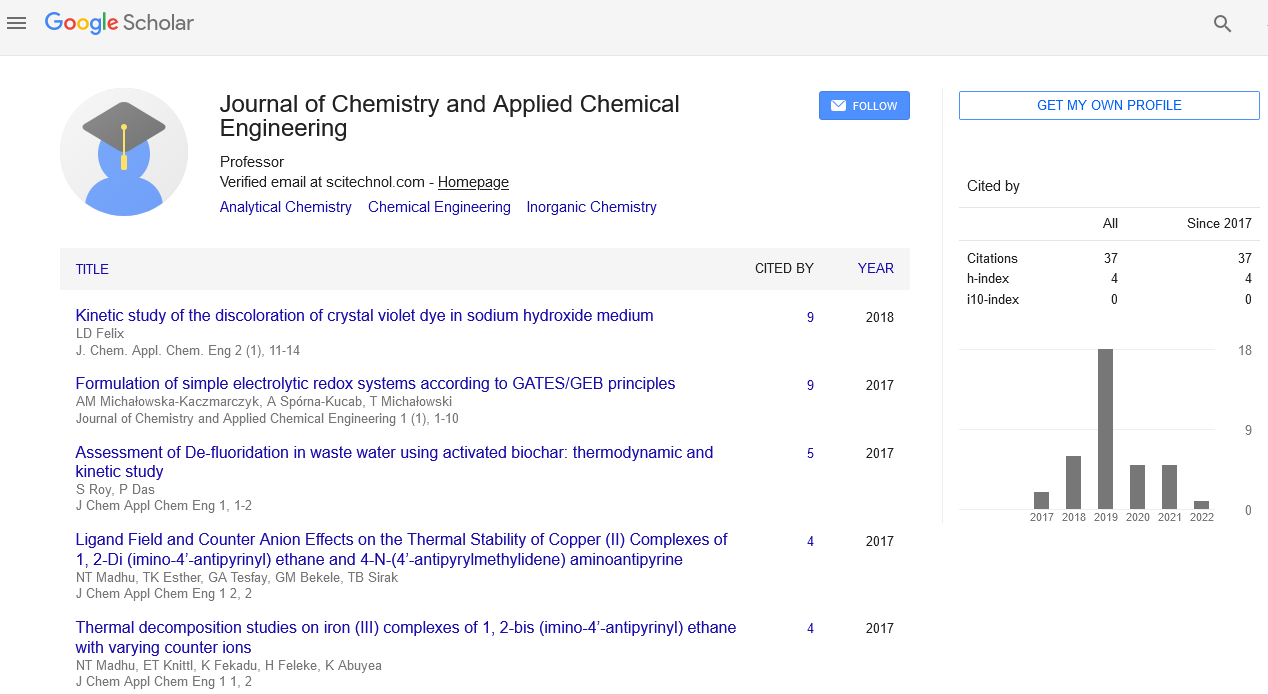Short Communication, J Chem Appl Chem Eng Vol: 7 Issue: 1
Design and Optimization of Catalytic Processes for Fine Chemical Synthesis
Aisling Scott E*
1Department of Chemical and Physical Sciences, Keele University, Keele, United Kingdom
*Corresponding Author: Aisling Scott E
Department of Chemical and Physical
Sciences, Keele University, Keele, United Kingdom
E-mail: scotte@keele.ais.ac.uk
Received date: 01 March, 2023, Manuscript No. JCACE-23-93114;
Editor assigned date: 03 March, 2023, Pre QC No. JCACE-23-93114(PQ);
Reviewed date: 17 March, 2023, QC No. JCACE-23-93114;
Revised date: 24 March, 2023, Manuscript No. JCACE-23-93114(R);
Published date: 31 March, 2023, DOI: 10.4172/Jcace.1000e016
Citation: Scott EA (2023) Design and Optimization of Catalytic Processes for Fine Chemical Synthesis. J Chem Appl Chem Eng 7:1.
Description
Catalysis is the process of increasing the rate of a chemical reaction by adding a substance called a catalyst. Catalysts play a vital role in many industrial processes, including fine chemical synthesis. Fine chemicals are high-value chemicals used in various industries such as pharmaceuticals, agrochemicals, and specialty chemicals. The optimization of catalytic processes for fine chemical synthesis involves the systematic improvement of chemical reactions that use catalysts to produce valuable chemical products.
The first step in optimizing catalytic processes is to identify the best catalyst. The catalyst should be selective, efficient, and cost-effective effective. It should also be stable and reusable. Various factors must be considered when selecting a catalyst, including the reaction conditions, reaction mechanism, and the desired product. A thorough understanding of the chemistry involved is essential to identify the best catalyst.
The next step in optimizing catalytic processes is to optimize the reaction conditions. The reaction conditions include temperature, pressure, reactant concentration, and catalyst loading. The goal is to find the optimal conditions that produce the highest yield of the desired product while minimizing unwanted byproducts. The reaction conditions must be carefully controlled to ensure reproducibility and consistency in the production process. Computer modeling and statistical analysis can be used to optimize the reaction conditions.
Characterizing the catalyst is an essential step in optimizing catalytic processes. The catalyst's physical and chemical properties, such as surface area, pore size, and chemical composition, can affect its performance. Various analytical techniques, such as X-ray diffraction, scanning electron microscopy, and infrared spectroscopy, can be used to characterize the catalyst. This information can be used to modify the catalyst's properties, leading to improved catalytic performance.
The preparation of the catalyst can also affect its performance. The method of catalyst preparation can impact the catalyst's physical and chemical properties, such as surface area and active site density. The catalyst's preparation method should be optimized to produce a catalyst with the desired properties. Techniques such as impregnation, precipitation, and sol-gel synthesis can be used to prepare catalysts.
Optimizing catalytic processes for fine chemical synthesis is critical for the production of high-value chemicals used in various industries. The process involves identifying the best catalyst, optimizing reaction conditions, characterizing the catalyst, and optimizing catalyst preparation. A thorough understanding of the chemistry involved, combined with analytical and statistical tools, can lead to the development of optimized catalytic processes that produce high yields of desired products while minimizing unwanted byproducts.
The reactor should be designed to ensure that the reactants are evenly distributed throughout the catalyst bed, and that the reaction conditions are maintained throughout the reaction. The reactor should also be designed to allow for the removal of heat generated during the reaction.
The design of the separation process is also important in catalytic processes. The separation process should be designed to separate the desired product from the reaction mixture and any unwanted byproducts. The separation process can involve distillation, crystallization, or other separation techniques.
In addition to the design of the catalytic process, it is also important to consider the environmental impact of the process. The use of toxic or hazardous catalysts should be avoided, and the process should be designed to minimize waste and energy consumption.
 Spanish
Spanish  Chinese
Chinese  Russian
Russian  German
German  French
French  Japanese
Japanese  Portuguese
Portuguese  Hindi
Hindi 